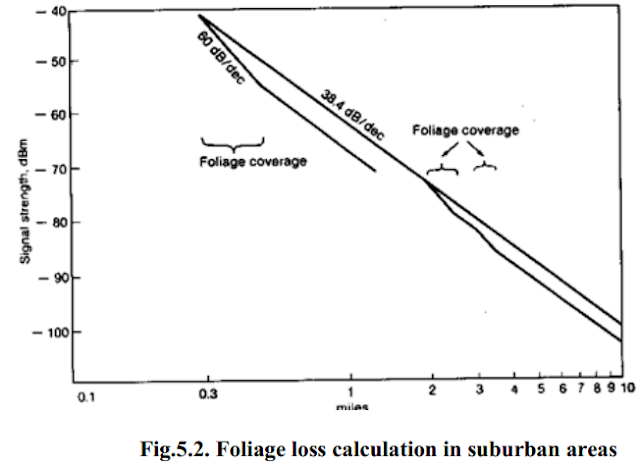Explain about foliage loss
5. Explain about foliage loss
Foliage loss is a very complicated topic that has many parameters and variations. The sizes of leaves, branches, and trunks, the density and distribution of leaves, branches, and trunks, and the height of the trees relative to the antenna heights all be considered. An illustration of this prv1em is shown in Fig. 5.1. There are three levels: trunks, branches, and leaves. In each level, there is a distribution of sizes of trunks, branches, and leaves and also of the density and spacing between adjacent trunks, branches, and leaves.The texture and thickness of the leaves also count. This unique problem can become very complicated and is beyond the scope of this book. For a system design, the estimate of the signal reception due to foliage loss does not need any degree of accuracy.
Furthermore, some trees, such as maple or oak, lose their leaves in winter, while others, such as pine, never do. For example, in Atlanta, Georgia, there are oak, maple, and pine trees. In summer the foliage is very heavy, but in winter the leaves of the oak and maple trees fall and the pine leaves stay. In addition, when the length of pine needles reaches approximately 6 in., which is the half wavelength at 800 MHz, a great deal of energy can be absorbed by the pine trees. In these situations, it is very hard to predict the actual foliage loss.
However, a rough estimate should be sufficient for the purpose of system design. In tropic zones, the sizes of tree leaves are so large and thick that the signal can hardly penetrate. In this case, the signal will propagate from the top of the tree and deflect to the mobile receiver. We will include this calculation also.
Sometime the foliage loss can be treated as a wire-line loss, in decibels per foot or decibels per meter, when the foliage is uniformly heavy and the path lengths are short. When the path length is long and the foliage is non uniform, then decibels per octaves or decibels per decade are used. In general, foliage lose occurs with respect to the frequency to the fourth power. Also, at 800 MHz the foliage Lou along the radio path is 40 dB/dec, which is 20 dB more than the free- space loss, with the same amount of additional loss for mobile communications. Therefore, if the situation involves both foliage loss and mobile communications, the total loss would be 60 dB/dec (=20 dB/ dec of free-space loss + additional 20 dB due to foliage loss + additional 20 dB due to mobile communication).
 |
| A characteristic of foliage environment |
This situation would be the case if the foliage would line up along the radio path. A foliage loss in a suburban area of 58.4 dB/dec is shown in Fig.5.2. As demonstrated from the above two examples, closein foliage at the transmitter site always heavily attenuates signal reception. Therefore, the cell site should be placed away from trees.
 |
| Foliage loss calculation in suburban areas |

